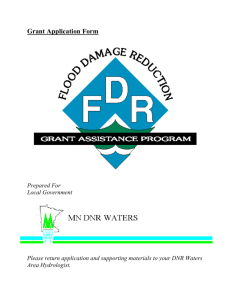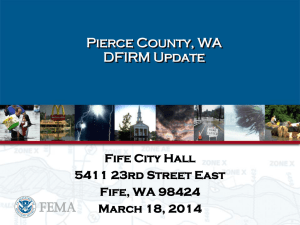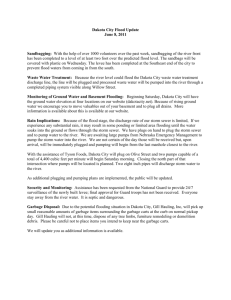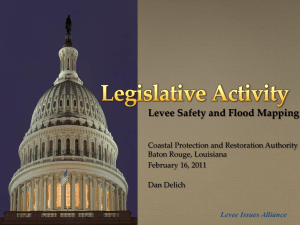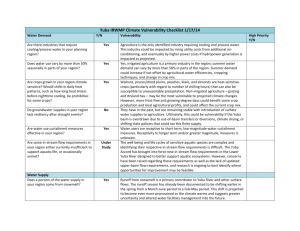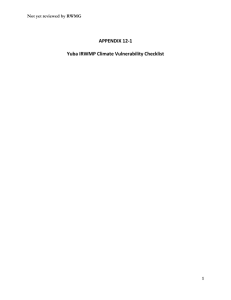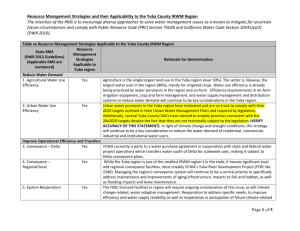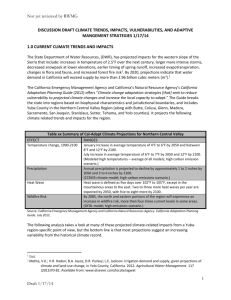Yuba County IRWMP_Gold Field Levee
advertisement
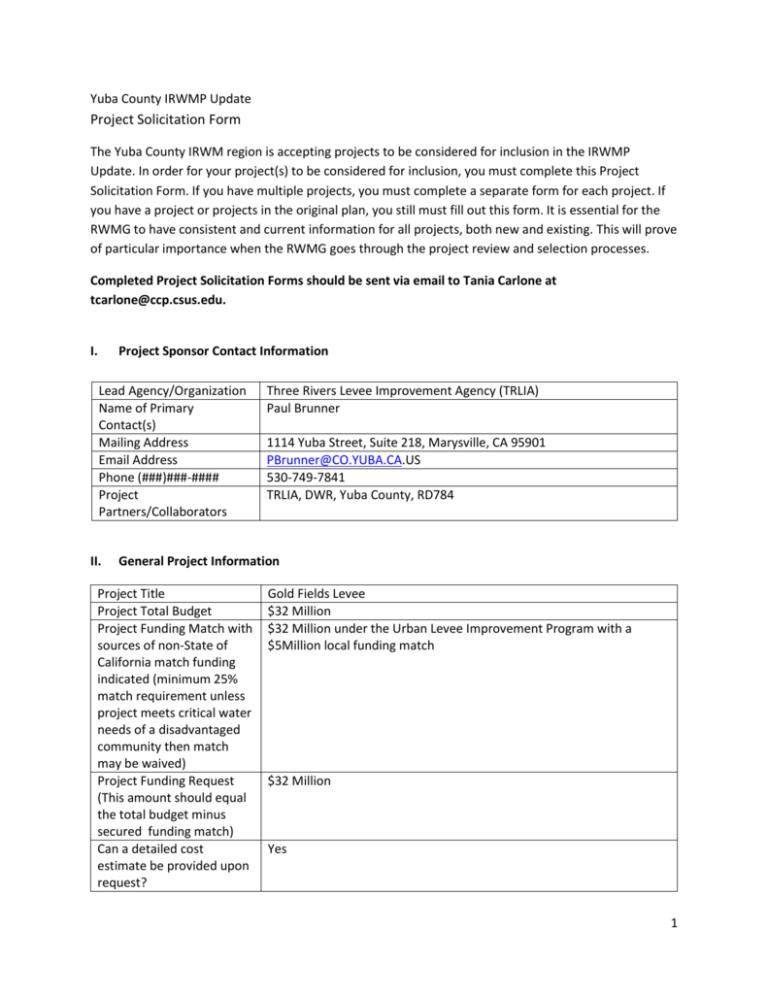
Yuba County IRWMP Update Project Solicitation Form The Yuba County IRWM region is accepting projects to be considered for inclusion in the IRWMP Update. In order for your project(s) to be considered for inclusion, you must complete this Project Solicitation Form. If you have multiple projects, you must complete a separate form for each project. If you have a project or projects in the original plan, you still must fill out this form. It is essential for the RWMG to have consistent and current information for all projects, both new and existing. This will prove of particular importance when the RWMG goes through the project review and selection processes. Completed Project Solicitation Forms should be sent via email to Tania Carlone at tcarlone@ccp.csus.edu. I. Project Sponsor Contact Information Lead Agency/Organization Name of Primary Contact(s) Mailing Address Email Address Phone (###)###-#### Project Partners/Collaborators II. Three Rivers Levee Improvement Agency (TRLIA) Paul Brunner 1114 Yuba Street, Suite 218, Marysville, CA 95901 PBrunner@CO.YUBA.CA.US 530-749-7841 TRLIA, DWR, Yuba County, RD784 General Project Information Project Title Project Total Budget Project Funding Match with sources of non-State of California match funding indicated (minimum 25% match requirement unless project meets critical water needs of a disadvantaged community then match may be waived) Project Funding Request (This amount should equal the total budget minus secured funding match) Can a detailed cost estimate be provided upon request? Gold Fields Levee $32 Million $32 Million under the Urban Levee Improvement Program with a $5Million local funding match $32 Million Yes 1 Project Location: South of Gold Fields in Yuba County Latitude Longitude Could you provide a map of Yes the project location including boundaries upon request? Project Location 3 mile east-west levee located just south of the Gold Fields starting at Description: the Upper Yuba River Levee and running east to High Ground near Beale AFB County Yuba City/Community Linda, Olivehurst, Plumas Lake Watershed/subwatershed/ Region-wide Groundwater Basin Project Type Planning (highlight in gray all the Facility Construction apply) Restoration Study/Assessment Monitoring Best Management Practices Acquisitions Demonstration/Pilot Project III. Project Description Write a narrative briefly describing the project (maximum of 300 words). Please be aware that this description will be the basis for what would ultimately be published in the Yuba County IRWM Plan. The 3 mile long east-west Gold Field Urban Levee would connect the Upper Yuba Levee to high ground to the east towards Beale AFB. This levee would complete the RD784 Urban Levee system and allow for 100 year and 200 year certification. This levee would be the last levee needed for certification and further reduce potential flooding risk for approximately 25,000 people and $3 Billion in assets. IV. Project Rationale/Issues Statement Briefly describe (maximum of 200 words) how the project addresses one or more of the region’s identified issues. The project will meet Urban Flood Management goals and increase the potential for economic growth by allowing for 100 year and 200 year flood control certification. This will reduce the amount of federal flood insurance premium taken from the community’s disposable income that can be invested or spend on consumer goods. V. Goals/Objectives/Performance Metrics 2 Identify the goals and objectives addressed by the project and provide a one to two sentence explanation of how the project contributes to the attainment of the goals and objectives. Additionally, identify the performance metrics that will be used to measure project success. See attached Goals, Objectives, Issues and Conflicts Draft Chapter. Goals Addressed by the Project Flood Control The project would complete the RD784 Urban Levee system and allow for 100 and 200 year flood protection. The project also protects regional water and sewage treatment facilities. Objectives Addressed by Project Attain State and US Corps of Engineers certifications. Reduce required FEMA Flood Insurance rates and impacted areas. What performance metrics will be used to demonstrate that objectives are being met? Attain State and federal certifications. Wherever possible, provide a quantitative measurement reflecting successful project outcomes. VI. Resource Management Strategies Based on your understanding of Resource Management Strategies (RMS) in the table below, indicate which RMS are employed by the project by providing a one to two sentence explanation of how the project incorporates the strategies. If you are uncertain of whether a particular RMS applies, let us know and we will work with you to determine the applicability of the strategy. For your reference, see attached Draft RMS Chapter. Reduce Water Demand Agricultural Water Use Efficiency Urban Water Use Efficiency Improve Operational Efficiency and Transfers Conveyance-- Delta Conveyance—Regional/Local System Reoperation Water Transfers NA Protects water facilities NA NA NA NA 3 Increase Water Supply Conjunctive Management and Groundwater Desalination Precipitation Enhancement Recycled Municipal Water Surface Storage-- CALFED Surface Storage-- Regional/Local Improve Water Quality Drinking Water Treatment and Distribution Groundwater and Aquifer Remediation Matching Water Quality to Use Pollution Prevention Salt and Salinity Management Urban Runoff Management Practice Natural Resources Stewardship Agricultural Lands Stewardship Economic Incentives (Loans, grants, and water pricing) Ecosystem Restoration Forest Management Land Use Planning and Management Recharge Areas Protection Water-dependent Recreation Watershed Management Improve Flood Management Flood Risk Management VII. NA NA NA NA NA NA Protects regional treatment facilities NA NA NA NA NA NA NA NA NA May allow additional urban infill development NA NA NA Will complete RD784 Urban Basin Protection Statewide Priorities Indicate the statewide priorities that the project addresses by highlighting in gray all those bulleted items that apply. Ultimately, you will be required to demonstrate how your project concretely addresses these priorities. Therefore, please carefully select priorities where you have relative certainty of their application. Drought Preparedness Promote water conservation, conjunctive use, reuse and recycling Improve landscape and agricultural irrigation efficiencies Achieve long term reduction of water use Efficient groundwater basin management System interties Use and Reuse Water More Efficiently 4 Increase urban and agricultural water use efficiency measures such as conservation and recycling Capture, store, treat, and use urban stormwater runoff (such as percolation to usable aquifers, underground storage beneath parks, small surface basins, domestic stormwater capture systems, or the creation of catch basins or sumps downhill of development Incorporate and implement low impact development (LID) design features, techniques, and practices to reduce or eliminate stormwater runoff Climate Change Response Actions Adaptation to Climate Change: Advance and expand conjunctive management of multiple water supply sources Adaptation to Climate Change: Use and reuse water more efficiently Adaptation to Climate Change: Water management system modifications that address anticipated climate Adaptation to Climate Change: Establish migration corridors, re-establish river-floodplain, hydrologic continuity, re-introduce anadromous fish populations to upper watersheds, enhance and protect upper watershed forests and meadow systems Reduction of Greenhouse Gas (GHG) Emissions: Reduce energy consumption of water systems and uses Reduction of GHG Emissions: Use cleaner energy sources to move and treat water Reduce Energy Consumption: Water use efficiency Reduce Energy Consumption: Water recycling Reduce Energy Consumption: Water system energy efficiency Expand Environmental Stewardship Expand environmental stewardship to protect and enhance the environment by improving watershed, floodplain, and instream functions and to sustain water and flood management ecosystems Practice Integrated Flood Management Better emergency preparedness and response Improved flood protection More sustainable flood and water management systems Enhanced floodplain ecosystems LID techniques that store and infiltrate runoff while protecting groundwater Protect Surface and Groundwater Quality Protecting and restoring surface water and groundwater quality to safeguard public and environmental health and secure water supplies for beneficial uses Salt/nutrient management planning as a component of an IRWM Plan 5 Improve Tribal Water and Natural Resources Improve Tribal Water and Natural Resources and include the development of tribal consultation, collaboration, and access to funding for water programs Ensure Equitable Distribution of Benefits Increase the participation of small and disadvantaged communities in the IRWM process Develop multi-benefit projects with consideration of affected disadvantaged communities and vulnerable populations Contain projects that address safe drinking water and wastewater treatment needs of DACs Address critical water supply or water quality needs of California Native American tribes within the region Climate Change Adaptation (maximum 200 words) Briefly describe how the project assists the region in adapting to the effects of climate change. Also, describe how well you anticipate the project will perform when considering the projected effects of climate change, such as more extreme weather events, warmer/dryer conditions, earlier snowmelt, etc. GHG Emissions Reduction (maximum 200 words) Briefly describe how the project mitigates for GHG emissions. Additionally, describe the process by which the project considered GHG reduction among project alternatives. See below (at end of form) GHG Reduction Considerations for Project Design and Alternatives. VIII. Project Status and Schedule Determine the status of the project by indicating if it is in a conceptual stage. If it is further developed, describe the level of completion in each project stage. Additionally, describe the activities and expected schedule for each stage. For Conceptual Projects Only: The Project is currently in the Conceptual Stage: YES (highlight in gray if applicable) Note: If the project is in the conceptual stage only, do not fill out the following table. Project Stage Planning Design Description of Activities in Each Project Stage Pending Pending Planned/Actual Start Date Pending funding Pending funding Planned/Actual Completion Date Pending funding Pending funding 6 Environmental Documentation (CEQA/NEPA) Permitting Tribal Consultation (if not applicable, indicate by N/A) Construction/ Implementation IX. Pending Pending funding Pending funding Pending NA Pending funding Pending funding Pending funding Pending funding Pending Pending funding Pending funding Project Technical Feasibility Provide any related documents that describe and confirm the technical feasibility of your project. a. List the water planning documents that specifically identify this project. b. List the adopted planning documents the proposed project is consistent with (e.g., General Plans, UWMPs, GWMPs, Water Master Plans, Habitat Conservation Plans, etc.) c. List technical reports and studies supporting the feasibility of this project. If you are an Urban Water Supplier: 1. Have you completed an Urban Water Management Plan and submitted to DWR? 2. Are you in compliance with AB1420? 3. Do you comply with the water meter requirements (CWC Section 525)? 4. If the answer to any of the questions above is “no,” do you intend to comply prior to receiving project funding? If you are an Agricultural Water Supplier: 1. Have you completed and submitted an AWMP? TRLIA Board Adopted project at the 3/3/2105 meeting. The project is consistent with the Yuba County General Plan and consistent with the Central Valley Flood Protection Board’s State Plan of Flood Control. TRLIA Technical Review NA NA NA NA NA 7 2. If not, will you complete an AWMP prior to receiving project funding? If the project is related to groundwater: 1. Has GWMP been completed and submitted for the subject basin? 2. If not, will the GWMP be completed within one year of the grant submittal date? NA NA NA GHG Reduction Considerations for Project Design and Alternatives IRWM Guidelines suggest that common emissions sources from projects are related to: Operations of construction equipment Passenger vehicle trips during construction and operation Transportation of construction materials and equipment Transportation of material inputs for O&M Transportation of material outputs or production Generation of electricity used for operation of projects Waste generation and disposal of materials during construction and operation Reduction strategies during project design and project mitigations under CEQA/NEPA review could include any of the applicable measures listed below: Project construction-related transportation Offer local contractor preference and local purchase of construction materials where possible to reduce transportation-related emissions Encourage or require carpooling within construction contracts Encourage use of B20 fuels in construction equipment and other diesel machinery Restrict inappropriate OHV use, particularly in sensitive or restored areas where project investments have been made Project construction-related emissions Encourage or require recycling of construction waste, such as brick, concrete, lumber, metal, and dry wall, as may be required within Shasta County from the proposed Lumber Waste Diversion Ordinance Pursue projects in this Plan that would use biomass from fuels reduction projects Capture sequestration opportunities with forest, sage-steppe, riparian, and grassland revegetation, stabilization, and restoration projects Water supply and water efficiency improvements Select project components and upgrades, such as pumps, based on energy efficiency Schedule pumping to reduce peak hour (12:00 to 5:00, highest carbon output) energy use Select projects that offer the best water conservation options among project choices (e.g., greatest reuse/recycling, greatest reduction in leakage or evaporation per mile) Install solar generation equipment for pumping and other energy-generation needs to reduce both emissions and long-term O&M costs 8 Increase conservation/reduce water use (and thus the energy and emissions related to its delivery) with increased metering, favorable rate incentives for conservation, and education within utility bills 9



